Off Grid Living Interior Design: Creating Sustainable Spaces for Modern Lifestyles
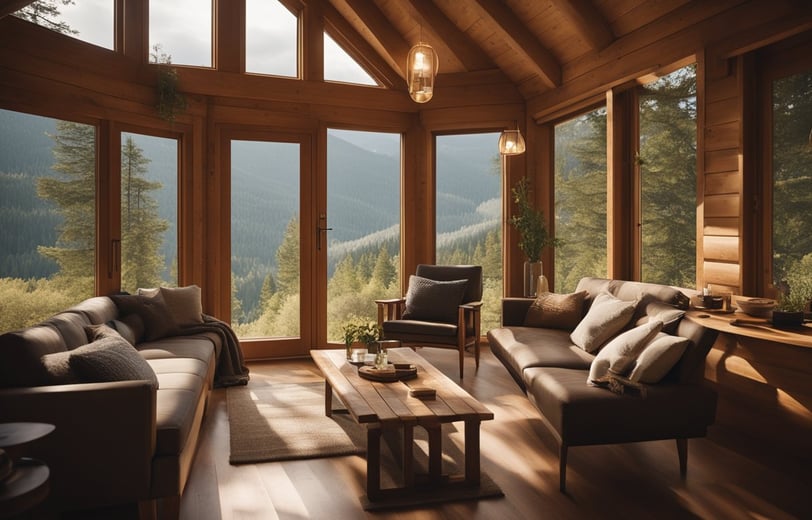

Off-grid living offers a unique opportunity to blend sustainable practices with personalized interior design. Creating a functional and aesthetically pleasing space requires careful consideration of materials, layout, and innovative storage solutions. This approach not only enhances the livability of off-grid homes but also reflects individual style and values.
The choices made in off-grid interior design can significantly affect daily life in these self-sufficient environments. Incorporating eco-friendly materials and efficient space planning leads to comfort while respecting nature. By prioritizing practicality alongside visual appeal, off-grid dwellers can enjoy a truly harmonious living experience.
Exploring this intersection of design and sustainability provides insight into how anyone can create a beautiful sanctuary that meets their needs without relying on conventional utilities. Practical tips can guide the way to a seamless integration of artistry and functionality.
Key Takeaways
Off-grid interior design balances sustainability with personal aesthetics.
Effective space planning enhances both the functionality and comfort of self-sufficient homes.
Choosing eco-friendly materials contributes to a healthier living environment.
Essentials of Off-Grid Interior Design
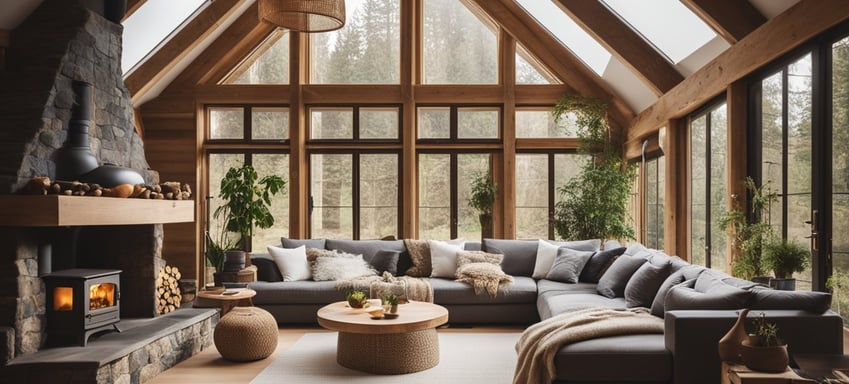

Effective off-grid interior design focuses on sustainability and comfort while utilizing available resources. Key elements include enhancing natural light and integrating renewable energy solutions.
Maximizing Natural Light
Natural light plays a crucial role in off-grid design. It reduces reliance on artificial lighting and creates an inviting atmosphere. To achieve this, consider the following strategies:
Large Windows: Install oversized windows or glass doors to capture as much sunlight as possible. South-facing windows are particularly effective in maximizing light exposure.
Light Colors: Use light-colored walls and furnishings to reflect sunlight within the space. This helps to enhance brightness without requiring additional energy.
Open Floor Plans: Design an open layout to facilitate the flow of natural light throughout the home. Avoid heavy partitions that could block sunlight.
Implementing these strategies not only emphasizes the beauty of the environment but also promotes energy efficiency.
Incorporating Renewable Energy Sources
Utilizing renewable energy sources is fundamental in off-grid living. Integrating these technologies ensures a reliable power supply while minimizing the environmental footprint. Key elements include:
Solar Panels: Install solar panels on rooftops to harness solar energy. This serves as the primary energy source for lighting, appliances, and heating.
Wind Turbines: In areas with consistent wind, small wind turbines can supplement solar energy, providing an alternative power source.
Energy Storage Solutions: Invest in batteries to store excess energy generated during peak production times. This ensures consistent power availability during low generation periods.
By employing these renewable energy solutions, she can create a sustainable and efficient living environment.
Functional Space Planning
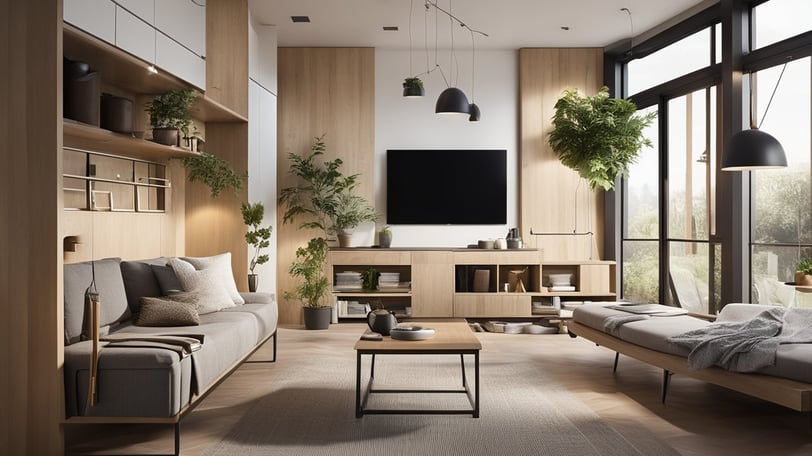

Effective space planning is essential for maximizing living comfort in an off-grid setting. By focusing on efficient use of space and zoning, individuals can create functional interiors that accommodate their daily needs.
Efficient Use of Space
In off-grid living, every square foot counts. Using vertical space can significantly increase functionality. Installing shelves or cabinets that reach the ceiling can provide ample storage without consuming floor area.
Multi-functional furniture serves a critical role too. For example, a sofa bed can serve as a seating area during the day and a sleeping space at night.
Using built-in furnishings also optimizes areas. Instead of standalone pieces, integrating furniture with the layout can create a seamless flow. Measuring available dimensions before purchasing items ensures they fit comfortably and support usability.
Zoning for Multi-Use Areas
Creating zones within a limited space allows for efficient functioning in an off-grid home. Designating specific areas for cooking, working, and relaxing can optimize daily routines.
For instance, a kitchen-living area can be separated by strategically placed furniture or partitions. This setup provides distinct areas while keeping the space open and inviting.
Flexible workspaces contribute to zoning efficiency. A dining table can double as a workspace when not in use for meals. Features like foldable desks can further enhance adaptability.
Incorporating area rugs can visually define different zones while maintaining an integrated look. Thoughtful zoning promotes organization and comfort, making day-to-day activities more manageable.
Sustainable Materials and Finishes

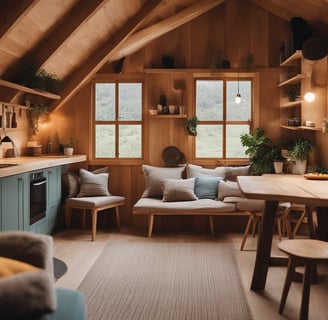
In an off-grid living space, selecting the right materials is crucial for sustainability. Eco-friendly fabrics and sustainable building materials contribute significantly to reducing the environmental impact while enhancing the interior design.
Choosing Eco-Friendly Fabrics
When selecting fabrics, prioritize those made from natural fibers, such as organic cotton, hemp, and linen. These materials are biodegradable, reducing waste in landfills.
Consider fabrics that are certified by standards like GOTS (Global Organic Textile Standard) to ensure they meet strict environmental criteria.
Look for recycled materials as well, such as polyester made from recycled plastic bottles. This reduces demand for new resources and helps minimize pollution.
For upholstery and curtains, opt for low-VOC (volatile organic compounds) options to improve indoor air quality. These fabrics not only enhance comfort but also promote health within the living space.
Selecting Sustainable Building Materials
Sustainable building materials play a vital role in off-grid interior design. Bamboo is a popular choice due to its rapid growth and durability. It can be used for flooring, furniture, and cabinetry, making it versatile.
Reclaimed wood is another excellent option, minimizing deforestation and repurposing existing materials. This offers unique aesthetics and character to the space.
Consider utilizing straw bales for insulation or wall construction. This resource is highly sustainable and provides excellent thermal performance.
Also, look for materials certified by organizations like FSC (Forest Stewardship Council), ensuring responsible sourcing. By choosing these sustainable materials, one can reduce their carbon footprint while creating a beautiful and functional off-grid home.
Innovative Storage Solutions
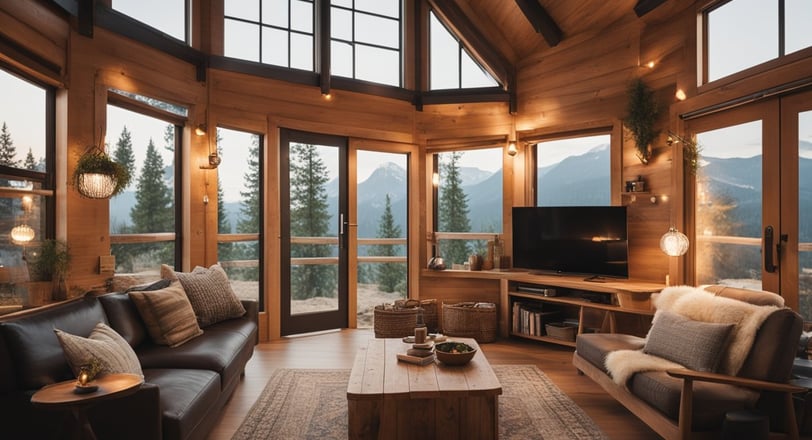

Effective storage is essential in off-grid living, where space may be limited. Utilizing innovative designs maximizes functionality while maintaining a minimalist aesthetic.
Built-In Storage Features
Built-in storage solutions make the most of available space by integrating cabinetry and shelving into walls. These features optimize areas that might otherwise remain unused, like under staircases or above doorways.
Custom-built shelves can display items while providing practical storage for books or supplies. Hidden storage compartments in furniture can offer concealed places for tools or outdoor gear.
Creating built-in benches with storage underneath can serve dual purposes; they provide seating and a place to stow away less frequently used items. Natural wood finishes can enhance the aesthetic, blending functionality with rustic charm.
Multi-Purpose Furniture
Multi-purpose furniture is essential in an off-grid design, enabling the efficient use of space. Pieces like sofa beds or expandable tables adapt to various functions, making them ideal for limited living areas.
Using ottomans with internal storage provides extra seating and space for blankets or games. DIY projects can also yield custom items, such as tables that convert into workspaces.
Foldable furniture offers versatility, allowing for easy storage when not in use. This concept works well for outdoor settings, where furniture needs to be moved or stored frequently. Adopting multi-purpose solutions ensures a practical and efficient living environment while maintaining comfort.
Personalization and Aesthetics
Creating an off-grid living space involves a unique opportunity to express individuality through design. Personal style and meaningful decoration enhance comfort and reflect personal values within the home.
Integrating Personal Style
In off-grid living, integrating personal style is crucial for making a space feel like home. This can be achieved by choosing color palettes that resonate personally.
Key considerations include:
Natural Materials: Emphasizing wood, stone, and other organic elements contributes to a holistic feel.
Textiles: Custom or locally sourced fabrics can add warmth and character.
Furniture Arrangement: Tailoring layouts to optimize space and comfort ensures functionality meets aesthetic desires.
Incorporating unique heirlooms or handmade items can also foster a sense of connection to the past, further personalizing the environment.
Art and Decoration with Purpose
Art and decoration in off-grid living go beyond mere aesthetics; they serve functional and emotional roles. Choosing pieces that tell a story can enrich the living experience.
Suggestions for selecting art include:
Local Artists: Supporting local artisans fosters community and enriches decor with unique flavors.
Nature-Inspired Themes: Artwork showcasing the surrounding environment can reinforce the connection to nature.
Functional Decor: Items like handmade pottery or woven baskets can serve practical purposes while enhancing visual appeal.
Prioritizing decoration that reflects personal values encourages mindfulness and sustainability, aligning with the principles of off-grid living.
